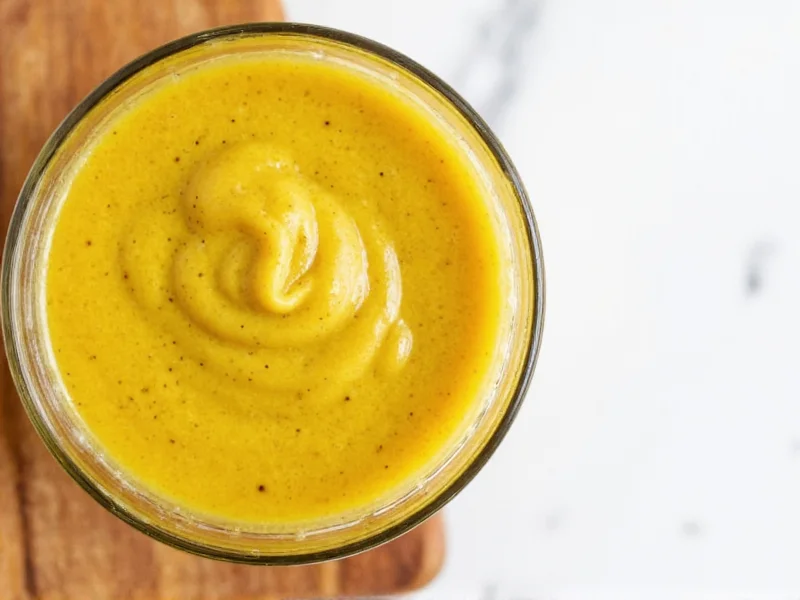When you're in the middle of cooking and realize you've run out of prepared mustard, knowing reliable alternatives can save your recipe. Prepared mustard—a smooth, creamy condiment made from ground mustard seeds, vinegar, water, and spices—adds distinctive tang and depth to dressings, marinades, and sauces. Understanding what makes it unique helps identify effective substitutes that maintain your dish's intended flavor profile.
What Makes Prepared Mustard Unique
Unlike dry mustard powder or whole grain mustard, prepared mustard has a smooth texture and balanced flavor profile combining tanginess from vinegar, subtle heat from mustard seeds, and often a touch of sweetness. Its emulsifying properties make it invaluable in dressings and sauces. When seeking a prepared yellow mustard substitute or Dijon mustard alternative, consider these key characteristics you need to replicate.
Top 5 Prepared Mustard Substitutes
Each substitute works best in specific applications. Consider your recipe's requirements before choosing:
| Substitute | Ratio | Best For | Flavor Notes |
|---|---|---|---|
| Yellow mustard + mayonnaise | 1:1 ratio | Cole slaw, sandwiches, dips | Creamier with milder tang |
| Vinegar + mustard powder | 1 tsp powder + 1 tbsp vinegar | Marinades, dressings | Closest flavor match |
| Sour cream + mustard powder | 2:1 ratio | Dips, creamy sauces | Richer, tangier profile |
| Horseradish + vinegar | 1:1 ratio | Meat glazes, robust dishes | Sharper heat, less tang |
| Homemade prepared mustard | Customizable | All applications | Most authentic flavor |
Detailed Substitute Analysis
Vinegar-Based Prepared Mustard Alternative
For recipes requiring the tangy component of prepared mustard, combine 1 teaspoon of mustard powder with 1 tablespoon of vinegar (white wine vinegar works best for Dijon-style substitution). This prepared mustard powder substitute replicates the essential acidic component while providing the characteristic mustard heat. Add a pinch of turmeric for color and ½ teaspoon of honey for sweetness to better match commercial prepared mustard.
Mayonnaise-Based Creamy Substitute
When texture matters more than intense mustard flavor—as in many sandwich spreads or creamy dressings—use equal parts yellow mustard and mayonnaise. This prepared yellow mustard substitute creates a smooth emulsion similar to commercial varieties. For a healthier alternative, substitute Greek yogurt for half the mayonnaise while maintaining the creamy texture.
Dairy-Based Options for Rich Dishes
Sour cream or plain yogurt combined with mustard powder (2:1 ratio) works exceptionally well in potato salad, deviled eggs, and creamy pasta salads. The dairy component softens the sharpness while maintaining the distinctive mustard flavor. This substitute for prepared mustard in creamy dishes provides better mouthfeel than vinegar-based alternatives.
Plant-Based Mustard Alternatives
Vegans or those avoiding dairy can create effective substitutes using tahini or cashew cream blended with mustard powder and apple cider vinegar. For every tablespoon of prepared mustard needed, use 1½ teaspoons of this mixture. This plant-based prepared mustard substitute works particularly well in dressings and vegan mayonnaise applications.
Homemade Prepared Mustard Recipe
When time permits, make your own prepared mustard by combining 2 tablespoons mustard powder, 3 tablespoons vinegar, 1 tablespoon water, 1 teaspoon honey, and ¼ teaspoon turmeric. Let the mixture sit for 15 minutes to allow flavors to develop. This homemade prepared mustard substitute closely matches commercial varieties and keeps for two weeks refrigerated.
Recipe-Specific Substitution Guide
Not all substitutes work equally well across different applications. Consider these specific recommendations:
- For salad dressings: Use vinegar-based substitute (1 tsp mustard powder + 1 tbsp vinegar) as it emulsifies effectively
- For meat marinades: Opt for horseradish-vinegar mixture for better flavor penetration
- For sandwich spreads: Choose the mayonnaise-yellow mustard combination for ideal texture
- For deviled eggs: Sour cream substitute provides the creamiest results
- For barbecue sauces: Use equal parts ketchup and yellow mustard as a quick alternative
Avoiding Common Substitution Mistakes
Many home cooks make these errors when substituting prepared mustard:
- Using straight mustard powder without liquid (creates unpleasant heat)
- Substituting with spicy brown mustard (alters flavor profile significantly)
- Not adjusting seasoning after substitution (may require additional salt or sweetener)
- Using oil-based substitutes in water-based recipes (causes separation)
- Overcompensating with quantity (start with 75% of required amount and adjust)
Remember that different mustard varieties serve distinct purposes. A good Dijon mustard substitute won't work identically to a yellow prepared mustard alternative due to flavor intensity differences. Always consider whether your recipe needs the tang, the heat, the emulsifying properties, or the distinctive mustard flavor before selecting your substitute.
Storage and Shelf Life Considerations
Homemade substitutes typically have shorter shelf lives than commercial prepared mustard. Vinegar-based mixtures last about one week refrigerated, while dairy-based alternatives should be used within 3-4 days. The mayonnaise substitute maintains freshness for approximately 5 days. For longer storage, prepare small batches of homemade prepared mustard and freeze in ice cube trays, then transfer to freezer bags for up to three months.











 浙公网安备
33010002000092号
浙公网安备
33010002000092号 浙B2-20120091-4
浙B2-20120091-4